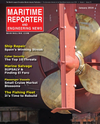
Page 12: of Maritime Reporter Magazine (January 2016)
Ship Repair & Conversion Edition
Read this page in Pdf, Flash or Html5 edition of January 2016 Maritime Reporter Magazine
GOVERNMENT UPDATE
Limitless Salvage
Whether driven by treasure hunting or environmental protection, the days of forgotten wrecks, even at great depths, is past.
BY DENNIS BRYANT t seems like every month we see re- the wreck of the HMS Royal George. Wreck removal consists of the re- de? ned as the exclusive economic zone ports of long-lost maritime wrecks Salvage vessels, equipment, tools, and moval of hazardous wrecks, generally (EEZ) of a State Party. Effectively, it being discovered on the ocean bot- techniques have progressed far in the having little or no salvage value. Tra- makes wreck removal within twelve
Itom and treasures being salvaged intervening years. Regular salvage and ditionally, the hazard involved a hazard nautical miles of shore subject to coastal from great depths. We also hear regu- treasure salvage have advanced apace. to maritime navigation – in other words, state law and wreck removal between larly of oil being recovered from sunken The 1910 Salvage Convention codi- a wreck where all or part of the sunken twelve and 200 nautical miles of shore wrecks. There is now no practical limit ? ed the traditional law of salvage, fo- vessel had so little clearance above it subject to the Convention provisions. to the ability to recover objects from the cused almost exclusively on the right of that other ships might strike it. Govern- Removal is de? ned as any form of pre- sea ? oor, regardless of depth, currents, salvage for remuneration. This conven- ment agencies, including the US Coast vention, mitigation, or elimination of the weather, or other obstacles. The only tion has been largely supplanted by the Guard and the US Army Corps of Engi- hazard created by a wreck. “Hazard” has existing obstacle seems to be ? nancing - 1989 Salvage Convention. One of the neers, require such hazardous wrecks in been expanded to cover not only dangers and costs are decreasing regularly. major developments in the new conven- navigable waters to be removed by the or impediments to navigation, but also a
Early salvors, such as Adolphus von tion was inclusion of a provision for spe- owner and to be properly marked until condition or threat that may reasonably
Treileben in the 1664 salvage of cannons cial compensation to be paid to salvors such removal is completed. be expected to result in major harmful from the Swedish warship Vasa, used a for work to prevent or lessen damage to The 2007 Wreck Removal Conven- consequences to the marine environment diving bell to allow personnel to work the environment caused or threatened by tion was primarily intended to provide or damage to the coastline or related in- at a moderate depth and still have access the wreck or its cargo. While the intent uniform international rules and proce- terests of one or more States.
to breathable air. The diving helmet and of this provision was admirable, special dures to ensure the prompt and effec- Subject to certain exceptions, the reg- dry suit were invented by Charles Deane, compensation salvage awards under this tive removal of wrecks and payment of istered owner of the wreck is liable for
John Deane, and Augustus Siebe in the provision have, in practice, proven to be compensation for the consequent costs. the costs of locating, marking, and re- 1830s and used to recover cannons from minimal. It applies within the “Convention area”, moving the wreck. The registered owner is also required to maintain insurance or other ? nancial security for such costs, up to the amount calculated under the
Convention on Limitation of Liability for Maritime Claims. This compulsory insurance provision is applicable to ves- sels of 300 gross tonnage and above ? y- ing the ? ag of a State Party and to similar vessels, wherever registered, entering or leaving a port of a State Party or arriving at or leaving from an offshore facility in the territorial sea of a State Party.
The Wreck Removal Convention en- tered into force on April 14, 2015. A to- tal of 25 nations, representing 58.09% of the world’s merchant ? eet, have rati? ed the Convention and become State Par- ties. As a result, the majority of the ves- sels engaged in international commerce now carry wreck removal insurance.
The United States has not rati? ed the
Wreck Removal Convention. Instead, it
The Evolution of Subsea Tech
As subsea technology has evolved, so too has the ability to work reliably, ef- ? ciently and safely in the most harsh environments on earth. Pictured is
Herbert Grove Dorsey with the Dorsey
Fathometer around 1930. (NOAA Photo Library) 12 Maritime Reporter & Engineering News • JANUARY 2016
MR #1 (10-17).indd 12 1/7/2016 4:39:42 PM

 11
11

 13
13
